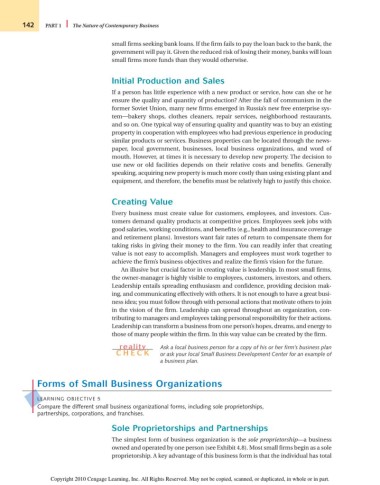Page 168 - Introduction to Business
P. 168
142 PART 1 The Nature of Contemporary Business
small firms seeking bank loans. If the firm fails to pay the loan back to the bank, the
government will pay it. Given the reduced risk of losing their money, banks will loan
small firms more funds than they would otherwise.
Initial Production and Sales
If a person has little experience with a new product or service, how can she or he
ensure the quality and quantity of production? After the fall of communism in the
former Soviet Union, many new firms emerged in Russia’s new free enterprise sys-
tem—bakery shops, clothes cleaners, repair services, neighborhood restaurants,
and so on. One typical way of ensuring quality and quantity was to buy an existing
property in cooperation with employees who had previous experience in producing
similar products or services. Business properties can be located through the news-
paper, local government, businesses, local business organizations, and word of
mouth. However, at times it is necessary to develop new property. The decision to
use new or old facilities depends on their relative costs and benefits. Generally
speaking, acquiring new property is much more costly than using existing plant and
equipment, and therefore, the benefits must be relatively high to justify this choice.
Creating Value
Every business must create value for customers, employees, and investors. Cus-
tomers demand quality products at competitive prices. Employees seek jobs with
good salaries, working conditions, and benefits (e.g., health and insurance coverage
and retirement plans). Investors want fair rates of return to compensate them for
taking risks in giving their money to the firm. You can readily infer that creating
value is not easy to accomplish. Managers and employees must work together to
achieve the firm’s business objectives and realize the firm’s vision for the future.
An illusive but crucial factor in creating value is leadership. In most small firms,
the owner-manager is highly visible to employees, customers, investors, and others.
Leadership entails spreading enthusiasm and confidence, providing decision mak-
ing, and communicating effectively with others. It is not enough to have a great busi-
ness idea; you must follow through with personal actions that motivate others to join
in the vision of the firm. Leadership can spread throughout an organization, con-
tributing to managers and employees taking personal responsibility for their actions.
Leadership can transform a business from one person’s hopes, dreams, and energy to
those of many people within the firm. In this way value can be created by the firm.
reality Ask a local business person for a copy of his or her firm’s business plan
CH ECK or ask your local Small Business Development Center for an example of
a business plan.
Forms of Small Business Organizations
LEARNING OBJECTIVE 5
Compare the different small business organizational forms, including sole proprietorships,
partnerships, corporations, and franchises.
Sole Proprietorships and Partnerships
The simplest form of business organization is the sole proprietorship—a business
owned and operated by one person (see Exhibit 4.8). Most small firms begin as a sole
proprietorship. A key advantage of this business form is that the individual has total
Copyright 2010 Cengage Learning, Inc. All Rights Reserved. May not be copied, scanned, or duplicated, in whole or in part.

